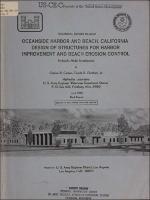Please use this identifier to cite or link to this item:
https://hdl.handle.net/11681/13598| Title: | Oceanside Harbor and Beach, California, design of structures for harbor improvement and beach erosion control : hydraulic model investigation |
| Authors: | United States. Army. Corps of Engineers. Los Angeles District Curren, Charles R. Chatham, C. E. (Claude E.) |
| Keywords: | Beach erosion Hydraulic models Breakwaters Jetties Erosion control Oceanside, California Oceanside Harbor Groins Shoaling Sedimentation Deposition Sediment transport Harbor structures Water waves Wave action Coastal structures |
| Publisher: | Hydraulics Laboratory (U.S.) Engineer Research and Development Center (U.S.) |
| Series/Report no.: | Technical report (U.S. Army Engineer Waterways Experiment Station) ; HL-80-10. |
| Description: | Technical Report Abstract: A 1:100 scale (undistorted) hydraulic model, reproducing Oceanside Harbor, approximately 5.7 miles of shoreline, and sufficient offshore area to permit generation of the required test waves was used to investigate the arrangement and design of proposed structures for (a) improving navigation and mooring and prevention of shoaling of Oceanside Harbor and (b) prevention of beach erosion. The proposed structures for the harbor consisted of (a) offshore breakwaters, (b) jetty extensions, (c) groins , and (d) interior breakwaters. The proposed structures for mitigation of beach erosion consisted of various groin and offshore breakwater configurations. A 190-ft-long wave generator, crushed coal tracer material, and an automated data acquisition and control system (ADACS) were used during model operation. For the harbor, it was concluded from model test results that : (1.) Existing conditions are characterized by strong longshore currents for moderate to large wave conditions with considerable longshore movement of material into and past the harbor entrance. The resultant shoal at the harbor entrance created hazardous entrance wave conditions due to breaking waves. Also, wave heights in certain areas of the harbor are excessive. Significant quantities of material pass into the harbor through the voids of the north jetty. (2.) The original improvement plan for prevention of harbor shoaling for Oceanside (i.e., the offshore breakwater plan of Plan 1) was ineffective in trapping material outside the harbor entrance and, in fact, contributed to the shoaling problem by trapping material in the entrance channel. (3.) The original improvement plan for wave protection to the harbor expansion (i.e., the inner breakwater of Plan 25) was ineffective in reducing wave heights to the level desired. (4.) Of the plans tested, Plans 4, 23, 24, 61, and 62 provided adequate prevention of harbor shoaling for all wave conditions tested. Plans 38C, 44, and 45 provided adequate prevention of harbor shoaling for waves from northerly directions and, if combined with the south jetty extension of Plan 21, would prevent shoaling for all wave conditions tested. Plan 4 required the greatest volume of rock. Plans 23 and 24 required less rock but would require bypassing large volumes of sand. Plans 38C, 44, and 45 (in conjunction wi th the south jetty extension of Plan 21) would require bypassing smaller volumes of sand due to the natural containment of sand by the groin. Plans 61 and 62 required the least volume of rock (no south jetty extension required) and would utilize the natural containment of sand by the groin. (5.) Many of the plans tested provided marginally adequate wave protection for the harbor expansion. However, considering all aspects of this expansion (entrance conditions, wave heights in berthing areas, harbor usage, cost and methods of construction, etc.), Plan 60 is considered the optimum based on results of the model tests (i.e. without regard to other factors). For the beach , it was concluded from model test results that: (1.) Existing conditions are characterized by strong longshore currents for moderate to large wave conditions with cons i derable longshore transport. (2.) The original improvement plan for Oceanside Beach (i.e. Plan 6, the 5-groin plan) was not effective in retaining the beach fill material and preventing erosion of the shoreline because of the spacing. (3.) Plans 9, 9B, 12, 14A, and 17 are all viable alternatives. Plan 12 protected the longest section of beach (from sta 47+00 to 175+00). And, due to the number of groins, used the largest volume of rock. Plans 9, 14A, and 17 were effective in protecting the beach fill between sta 105+00 and 155+00. These plans were effective in containing the beach fill and movement of tracer within the study area. The transitional groins of Plan 9B effectively minimized effects of the groin field on adjacent beaches. Such transitional groins could also be used effectively with Plans 14A and 17. NOTE: This file is large. Allow your browser several minutes to download the file. |
| Rights: | Approved for public release; distribution is unlimited. |
| URI: | http://hdl.handle.net/11681/13598 |
| Appears in Collections: | Technical Report |
Files in This Item:
| File | Description | Size | Format | |
|---|---|---|---|---|
| TR-HL-80-10.pdf | 32.03 MB | Adobe PDF |  View/Open |